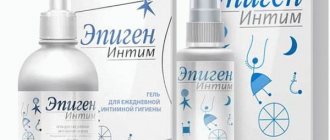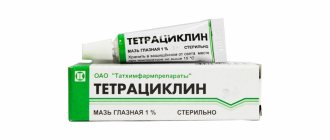Read the official detailed instructions for use of the drug Viferon Ointment
Viferon Ointment: instructions for use for children
| Is it possible to use VIFERON Ointment for infants and newborns? At what age can the drug be given to children? This antiviral drug can be used to treat ARVI and influenza in children over 1 year of age. For the treatment of children under 1 year old, VIFERON Suppositories (suppositories) and VIFERON Gel are used. | |
| For the treatment of ARVI in children from 1 to 2 years of age | VIFERON Ointment 2500 IU (1 pea with a diameter of 0.5 cm) 3 times a day. The duration of treatment is 5 days. |
| in children from 2 to 12 years old | ointment 2500 IU (1 pea with a diameter of 0.5 cm) 4 times a day. The duration of treatment is 5 days. |
| in children from 12 to 18 years old | ointment 5000 IU (1 pea with a diameter of 1 cm) 4 times a day. The duration of treatment is 5 days. |
Nosological classification (ICD-10)
- A41.9 Septicemia, unspecified
- A49.3 Mycoplasma infection, unspecified
- A59.0 Urogenital trichomoniasis
- A74.9 Chlamydial infection, unspecified
- B00.0 Herpetic eczema
- B00.1 Herpetic vesicular dermatitis
- B18 Chronic viral hepatitis
- B25.9 Cytomegalovirus disease, unspecified
- B34 Viral infection of unspecified localization
- B37.3 Candidiasis of the vulva and vagina (N77.1*)
- G03.9 Meningitis, unspecified
- J06 Acute upper respiratory tract infections of multiple and unspecified localization
- J11 Influenza, virus not identified
- J18 Pneumonia without specifying the pathogen
- N39.0 Urinary tract infection without established location
- N76 Other inflammatory diseases of the vagina and vulva
- O35.3 Fetal injury (suspected) due to maternal viral disease requiring maternal medical attention
- O35.8 Other fetal anomalies and lesions (suspected) requiring maternal medical attention
Compound
| Ointment for local and external use | 1 g |
| active substance: | |
| interferon human recombinant alpha-2 | 40000 IU |
| excipients: tocopherol acetate - 0.02 g; anhydrous lanolin - 0.34 g; medical petroleum jelly - 0.45 g; peach oil - 0.12 g; purified water - up to 1 g |
| Gel for local and external use | 1 g |
| active substance: | |
| interferon human recombinant alpha-2b | 36000 IU |
| excipients: alpha-tocopherol acetate - 0.055 g; methionine - 0.0012 g; benzoic acid - 0.00128 mg; citric acid monohydrate - 0.001 g; sodium tetraborate decahydrate - 0.0018 mg; sodium chloride - 0.004 g; human serum albumin solution 10% - 0.02 g; distilled glycerin (glycerol) - 0.02 g; carmellose sodium - 0.02 g; ethanol 95% - 0.055 g; purified water - up to 1 g |
| Suppositories for rectal use | 1 sup. |
| active substance: | |
| interferon human recombinant alpha-2b | 150000 IU |
| 500000 IU | |
| 1000000 IU | |
| 3000000 IU | |
| excipients: alpha-tocopherol acetate - 0.055/0.055/0.055/0.055 g; ascorbic acid - 0.0054/0.0081/0.0081/0.0081 g; sodium ascorbate - 0.0108/0.0162/0.0162/0.0162 g; disodium edetate dihydrate - 0.0001/0.0001/0.0001/0.0001 g; polysorbate 80 - 0.0001/0.0001/0.0001/0.0001 g | |
| base: cocoa butter and confectionery fat - up to 1 g |
Pharmacodynamics
Human recombinant interferon alpha-2b has pronounced immunomodulatory, antiviral, antiproliferative properties, suppresses the replication of RNA and DNA viruses.
The complex composition of the drugs (ointment, suppositories, gel) causes a number of new additional effects: in the presence of antioxidants (tocopherol acetate and/or ascorbic acid), the specific antiviral activity of human recombinant alpha-2b interferon increases, its immunomodulatory effect on T- and B-lymphocytes increases , the level of secretory immunoglobulins of class A increases, the level of immunoglobulin E normalizes, and the functioning of the endogenous interferon alpha-2b system is restored. Ascorbic acid and alpha-tocopherol acetate, being highly active antioxidants, have anti-inflammatory, membrane stabilizing, and regenerating properties. The use of the drug VIFERON® as part of complex therapy makes it possible to reduce therapeutic doses of antibacterial and hormonal drugs, as well as reduce the toxic effects of this therapy.
It has been established that when using the drug VIFERON® there are no side effects that occur with parenteral administration of interferon alfa-2b preparations, and no antibodies are formed that neutralize the antiviral activity of interferon alfa-2b.
How does VIFERON work?
When using the drug in the form of suppositories, the stomach does not experience additional stress, which is very important for pregnant women suffering from gastrointestinal diseases, including gastritis. The active ingredient of the drug does not put additional stress on the liver, which avoids many side effects. The ointment and gel act locally, penetrating the body only at the site of application.
Advantages of the drug VIFERON:
- has a wide spectrum of antiviral activity and does not cause the formation of resistant virus variants 5;
- blocks the proliferation of viruses and also restores the protective properties of the immune system, preventing intrauterine infection of the fetus and reducing the intensity of possible complications of pregnancy 3;
- optimal for combination therapy; goes well between its forms and with drugs used in the treatment of various infectious and inflammatory diseases (antibiotics, chemotherapy, glucocorticosteroids)
The use of the drug VIFERON® in the treatment of urogenital infections in order to improve the course and outcome of pregnancy contributes to:
- helps reduce the number of pathological conditions of a pregnant woman2;
- reduces the incidence of polyhydramnios by 1.9 times1;
- reduces the antigenic load on the body of the expectant mother and fetus1;
- reduces the risk of threatened abortion by 3.5 and 2.6 times, respectively3;
- reduces the number of patients with a positive HPV DNA test by 2.6 times4;
The use of the drug VIFERON® in pregnant women with urogenital infections in order to reduce the development of pathological conditions in the child contributes to:
- reduces the risk of developing severe forms of IUI by 1.7 times, and moderate forms of IUI by 1.9 times2;
- reduces the number of children with intrauterine growth retardation by 1.7 times2;
- reduces the incidence of asphyxia (oxygen starvation of the body) by 1.9 times2;
- reduces the number of newborns with damage to the central nervous system by 2.3 times2;
Immunomodulatory effect
In addition to interferon, VIFERON suppositories are enriched with antioxidants - vitamins E and C, which enhances the antiviral and immunomodulatory activity of the drug. Due to immunomodulatory properties, such as increased phagocytic activity of macrophages and specific immunotoxicity of lymphocytes, the drug has an indirect antibacterial effect, i.e. helps block the vital activity of not only viruses, but also bacteria.
Indications for the drug Viferon®
Ointment
viral (including herpetic) lesions of the skin and mucous membranes of various localizations;
treatment of influenza and acute respiratory viral infections in children over 1 year of age.
Gel
in complex therapy of ARVI, incl. influenza, frequent and prolonged acute respiratory viral infections, incl. complicated by bacterial infection;
prevention of acute respiratory viral infections, including influenza;
in complex therapy of recurrent stenotic laryngotracheobronchitis;
prevention of recurrent stenosing laryngotracheobronchitis;
in complex therapy of acute and exacerbations of chronic recurrent herpetic infections of the skin and mucous membranes, incl. urogenital form of herpetic infection;
in complex therapy of herpetic cervicitis.
Suppositories
In complex therapy:
ARVI, including influenza, incl. complicated by bacterial infection, pneumonia (bacterial, viral, chlamydial) in children and adults;
infectious and inflammatory diseases of newborns, incl. premature babies: meningitis (bacterial, viral), sepsis, intrauterine infection (chlamydia, herpes, CMV infection, enterovirus infection, candidiasis, including visceral, mycoplasmosis);
chronic viral hepatitis B, C, D in children and adults, incl. in combination with the use of plasmapheresis and hemosorption for chronic viral hepatitis of pronounced activity, complicated by cirrhosis of the liver;
infectious and inflammatory diseases of the urogenital tract (chlamydia, CMV infection, ureaplasmosis, trichomoniasis, gardnerellosis, papillomavirus infection, bacterial vaginosis, recurrent vaginal candidiasis, mycoplasmosis) in adults;
primary or recurrent herpetic infection of the skin and mucous membranes, localized form, mild to moderate course, incl. urogenital form in adults.
What infections are dangerous for pregnant women?
Pregnancy is accompanied by a state of physiological immunosuppression—immune suppression. This condition can lead to a decrease in protective, i.e. the body's defenses, contributing to primary infection, exacerbation of chronic infectious and inflammatory diseases and the development of pregnancy complications. Particularly dangerous are TORCH infections - a group of diseases that can be transmitted in utero from mother to child and cause various birth defects and diseases of the fetus.
The group of TORCH infections includes the following diseases:
- T – toxoplasmosis;
- O – other infections (others): syphilis (treponema pallidum), HIV, chicken pox, chlamydia, hepatitis B and C;
- R – rubella (rubella);
- C – cytomegalovirus infection or CMV (cytomegalovirus);
- H – herpes (herpes simplex virus).
If the mother has at least one such infection and in the absence of adequate therapy during pregnancy, up to 50% of newborns are born with various disorders:
- IUI (intrauterine infections);
- intrauterine growth retardation (IUGR);
- malnutrition (chronic malnutrition), etc.
With a mixed infection (in the presence of two or more infections), the incidence reaches 50-100%1. For the expectant mother, acute respiratory viral infections, including influenza, are very dangerous, which, due to decreased immunity, are fraught with the development of bacterial complications (pneumonia, otitis media, sinusitis).
Use during pregnancy and breastfeeding
Ointment: since when applied externally and locally, the systemic absorption of interferon is low and the drug has an effect only in the lesion, it is possible to use the drug VIFERON® during pregnancy and lactation.
Gel: since the systemic absorption of interferon when applied topically is low and the drug has an effect only in the lesion, it is possible to use the drug VIFERON® during pregnancy and breastfeeding. During lactation, do not use the drug on the area of the nipples and areola.
Suppositories: the drug is approved for use from the 14th week of pregnancy. There are no restrictions for use during lactation.
What to do if you get sick during pregnancy
Consult a specialist
Infectious diseases in an expectant mother require an integrated approach to the selection of effective and safe drugs with the obligatory participation of a therapist, infectious disease specialist and gynecologist. This is especially true for antiviral and antimicrobial agents. The most commonly used antiviral drugs contain interferons, but not all of them are suitable for treating pregnant women.
What interferons can you take?
Decades of use of drugs containing interferons have shown their high activity against many viruses. However, many parenteral (injectable) interferons are not recommended for use during pregnancy due to the high risk of side effects.
What is still allowed for expectant mothers?
In case of illness, you can use only reliable, time-tested drugs that are approved for pregnant women, which must be indicated in the instructions. One of these antiviral drugs is VIFERON. This drug is available in the form of suppositories, ointment or gel. He carefully takes care of women’s health and also promotes the birth of a healthy baby.3
Side effects
Ointment: in most cases, VIFERON® is well tolerated. When applied to the nasal mucosa, side effects are weak and transient and disappear on their own after discontinuation of the drug.
Gel: in extremely rare cases, a local allergic reaction may occur in some highly sensitive individuals. In such cases, stop using the drug.
Suppositories: in rare cases - allergic reactions (skin rashes, itching). These phenomena are reversible and disappear 72 hours after stopping the drug.
Directions for use and doses
Ointment, externally and locally. For herpes infection, apply a thin layer of ointment to the affected areas 3-4 times a day and rub in gently. Duration of treatment is 5–7 days. It is recommended to begin treatment immediately when the first signs of damage to the skin and mucous membranes appear (itching, burning, redness). When treating recurrent herpes, it is advisable to begin treatment in the prodromal period or at the very beginning of the appearance of signs of relapse.
To treat influenza and other acute respiratory viral infections, the ointment is applied in a thin layer to the mucous membrane of the nasal passages 3-4 times a day throughout the entire period of the disease.
Children from 1 year to 2 years - 2500 IU (1 pea with a diameter of 0.5 cm) 3 times a day; from 2 to 12 years - 2500 IU (1 pea with a diameter of 0.5 cm) 4 times a day; from 12 to 18 years - 5000 IU (1 pea with a diameter of 1 cm) 4 times a day. The duration of treatment is 5 days.
Gel, externally and locally.
In the complex therapy of ARVI, including influenza, long-term and frequent ARVI, incl. complicated by a bacterial infection: a strip of gel no more than 0.5 cm long is applied to the previously dried surface of the nasal mucosa and/or to the surface of the tonsils 3-5 times a day using a spatula or a cotton swab/cotton swab (see Note). The course of treatment is 5 days; if necessary, the course can be extended.
Prevention of ARVI, including influenza: during the period of rising incidence, a strip of gel no more than 0.5 cm long is applied to the previously dried surface of the nasal mucosa and/or to the surface of the tonsils 2 times a day for 2–4 weeks.
In complex therapy of recurrent stenosing laryngotracheobronchitis: a strip of gel no more than 0.5 cm long is applied to the surface of the palatine tonsils using a spatula or a cotton swab/cotton swab in the acute period of the disease 5 times a day, for 5–7 days, then 3 times a day day for the next 3 weeks.
Prevention of recurrent stenosing laryngotracheobronchitis: a strip of gel no more than 0.5 cm long is applied to the surface of the tonsils using a spatula or a cotton swab/cotton swab 2 times a day for 3-4 weeks, courses are repeated 2 times a year.
In complex therapy of acute and chronic recurrent herpetic infection (at the first signs of the disease or during the period of warning signs): a strip of gel no more than 0.5 cm long is applied using a spatula or a cotton swab/cotton swab to a previously dried affected surface 3–5 times per day. day for 5–6 days, if necessary, the duration of the course is increased until clinical manifestations disappear.
In complex therapy of herpetic cervicitis: 1 ml of gel is applied with a cotton swab to the surface of the cervix, previously cleared of mucus, 2 times a day for 7 days; if necessary, the duration of the course can be increased to 14 days.
Note. The gel is applied to the mucous membrane of the nasal cavity after cleansing the nasal passages, and to the surface of the palatine tonsils - 30 minutes after eating. When applying the gel to the tonsils, do not touch the tonsils with a cotton swab, but only with the gel; the gel flows down on its own along the surface of the tonsil. When applying the gel to the cervix, you should first remove mucus and discharge from the vaginal vaults and cervix with a cotton or gauze swab.
When applying the gel to the affected areas of the skin and mucous membranes, after 30–40 minutes a thin film is formed, onto which the drug is again applied. If desired, the film can be peeled off or washed off with water before reapplying the drug.
Suppositories, rectally.
1 suppository contains human recombinant interferon alpha-2b as an active substance in the indicated dosages (150,000 IU, 500,000 IU, 1,000,000 IU, 3,000,000 IU).
Acute respiratory viral infections, including influenza, incl. complicated by bacterial infection, pneumonia (bacterial, viral, chlamydial) in children and adults as part of complex therapy. Recommended dose for adults, including pregnant women and children over 7 years old VIFERON® 500,000 IU, 1 suppository 2 times a day after 12 hours every day for 5 days. According to clinical indications, therapy can be continued.
Children under 7 years old, incl. For newborns and premature infants with a gestational age of more than 34 weeks, it is recommended to use the drug VIFERON® 150,000 IU, 1 suppository 2 times a day after 12 hours every day for 5 days. According to clinical indications, therapy can be continued. The break between courses is 5 days.
Premature newborns with a gestational age of less than 34 weeks are recommended to use the drug VIFERON® 150,000 IU, 1 suppository 3 times a day after 8 hours every day for 5 days. According to clinical indications, therapy can be continued. The break between courses is 5 days.
Infectious and inflammatory diseases of newborns, incl. premature babies: meningitis (bacterial, viral), sepsis, intrauterine infection (chlamydia, herpes, CMV infection, enterovirus infection, candidiasis, including visceral, mycoplasmosis) as part of complex therapy. Recommended dose for newborns, incl. premature babies with a gestational age of more than 34 weeks VIFERON® 150,000 IU daily, 1 suppository 2 times a day after 12 hours. The course of treatment is 5 days.
Premature newborns with a gestational age of less than 34 weeks are recommended to use the drug VIFERON® 150,000 IU daily, 1 suppository 3 times a day after 8 hours. The course of treatment is 5 days.
Recommended number of courses for various infectious and inflammatory diseases: sepsis - 2-3 courses, meningitis - 1-2 courses, herpes infection - 2 courses, enterovirus infection - 1-2 courses, CMV infection - 2-3 courses, mycoplasmosis, candidiasis , including visceral - 2-3 courses. The break between courses is 5 days. According to clinical indications, therapy can be continued.
Chronic viral hepatitis B, C, D in children and adults as part of complex therapy, incl. in combination with the use of plasmapheresis and hemosorption for chronic viral hepatitis of pronounced activity, complicated by cirrhosis of the liver. The recommended dose for adults is VIFERON® 3,000,000 IU, 1 suppository 2 times a day every 12 hours every day for 10 days, then 3 times a week every other day for 6–12 months. The duration of treatment is determined by clinical effectiveness and laboratory parameters.
For children under 6 months of age, 300,000–500,000 IU per day is recommended; at the age of 6 to 12 months - 500,000 IU per day.
For children aged 1 to 7 years, 3,000,000 IU per 1 m2 of body surface area per day is recommended.
For children over 7 years old, 5,000,000 IU per 1 m2 of body surface area per day is recommended.
The drug is used 2 times a day every 12 hours for the first 10 days, then 3 times a week every other day for 6–12 months. The duration of treatment is determined by clinical effectiveness and laboratory parameters.
The daily dose of the drug for each patient is calculated by multiplying the recommended dose for a given age by the body surface area calculated using the nomogram for calculating body surface area by height and weight according to Garford, Terry and Rourke. The calculation of a single dose is carried out by dividing the calculated daily dose into 2 administrations, the resulting value is rounded up to the dosage of the suppository.
In case of chronic viral hepatitis of pronounced activity and liver cirrhosis, before plasmapheresis and/or hemosorption, it is recommended to use VIFERON® 150,000 IU for children under 7 years of age, VIFERON® 500,000 IU for children over 7 years of age, 1 suppository 2 times a day every 12 hours. within 14 days.
Infectious and inflammatory diseases of the urogenital tract (chlamydia, CMV infection, ureaplasmosis, trichomoniasis, gardnerellosis, papillomavirus infection, bacterial vaginosis, recurrent vaginal candidiasis, mycoplasmosis) in adults, including pregnant women as part of complex therapy. The recommended dose for adults is VIFERON® 500,000 IU, 1 suppository 2 times a day after 12 hours every day for 5–10 days. According to clinical indications, therapy can be continued.
Pregnant women from the second trimester of pregnancy (starting from 14 weeks of gestation) are recommended VIFERON® 500,000 IU, 1 suppository 2 times a day every 12 hours for 10 days, then 3 times for 9 days with an interval of 3 days (on the 4th day) 1 suppository 2 times a day after 12 hours. Then every 4 weeks until delivery VIFERON® 150,000 IU, 1 suppository 2 times a day after 12 hours every day for 5 days. If necessary, it is indicated before delivery (from 38 weeks of gestation) VIFERON® 500,000 IU, 1 suppository 2 times a day after 12 hours every day for 10 days.
Primary or recurrent herpetic infection of the skin and mucous membranes, localized form, mild to moderate course, incl. urogenital form in adults, including pregnant women. The recommended dose for adults is VIFERON® 1,000,000 IU, 1 suppository 2 times a day after 12 hours every day for 10 days or more for recurrent infections. According to clinical indications, therapy can be continued. It is recommended to begin treatment immediately when the first signs of damage to the skin and mucous membranes appear (itching, burning, redness). When treating recurrent herpes, it is advisable to begin treatment in the prodromal period or at the very beginning of signs of relapse.
Pregnant women from the second trimester of pregnancy (starting from 14 weeks of gestation) are recommended VIFERON® 500,000 IU, 1 suppository 2 times a day every 12 hours for 10 days, then 3 times for 9 days with an interval of 3 days (on the 4th day) 1 suppository 2 times a day after 12 hours. Then every 4 weeks until delivery VIFERON® 150,000 IU, 1 suppository 2 times a day after 12 hours every day for 5 days. If necessary, it is indicated before delivery (from 38 weeks of gestation) VIFERON® 500,000 IU, 1 suppository 2 times a day after 12 hours every day for 10 days.
Prevention of infections in pregnant women
Having identified cytomegalovirus, herpetic, chlamydial or mycoplasma infections before pregnancy, each woman, in agreement with the attending physician, can undergo a course of complex therapy, including VIFERON, to reduce the risk of relapse of the disease during pregnancy, as discussed above. And to prevent ARVI in the cold season, expectant mothers can use VIFERON Gel.
Author of the article
Belyaev Dmitry Alexandrovich
General doctor
- Budanov P.V., Strizhakov A.N. “Etiology, pathogenesis, diagnosis and treatment of intrauterine infection”, Issues of gynecology, obstetrics and perinatology, 2010.
- Bocharova I.I., Malinovskaya V.V., Aksenov A.N., Bashakin N.F., Guseva T.S., Parshina O.V. “The influence of viferon therapy in mothers as part of the treatment of urogenital infections during pregnancy on the immunity parameters and health status of their newborns,” 2009.
- P.V. Budanov, A.N. Strizhakov, V.V. Malinovskaya, Yu.V. Kazarova, “Discoordination of systemic inflammation during intrauterine infection”, Issues of gynecology, obstetrics and perinatology, 2009.
- Klimanova R.R., Malinovskaya V.V., Parshina O.V., Guseva T.S., Novikova S.V., Torshina Z.V., Zarochentseva N.V. “The influence of viral infections on the cytokine profile in pregnant women with a complicated obstetric history and immunocorrective therapy with human interferon alpha-2b,” 2013.
- Maksimov V.A., Chernyshev A.L., Zelentsov S.N., Neronov V.A., Vyzhlova E.N., Guseva T.S., Parshina O.V. “ Viferon therapy through the prism of evidence-based medicine ” collection of materials from the scientific and practical conference “Modern possibilities for diagnosing and treating diseases of the digestive system from the perspective of evidence-based medicine,” Pp. 148-158, 2011
Loading...
Take other surveys





